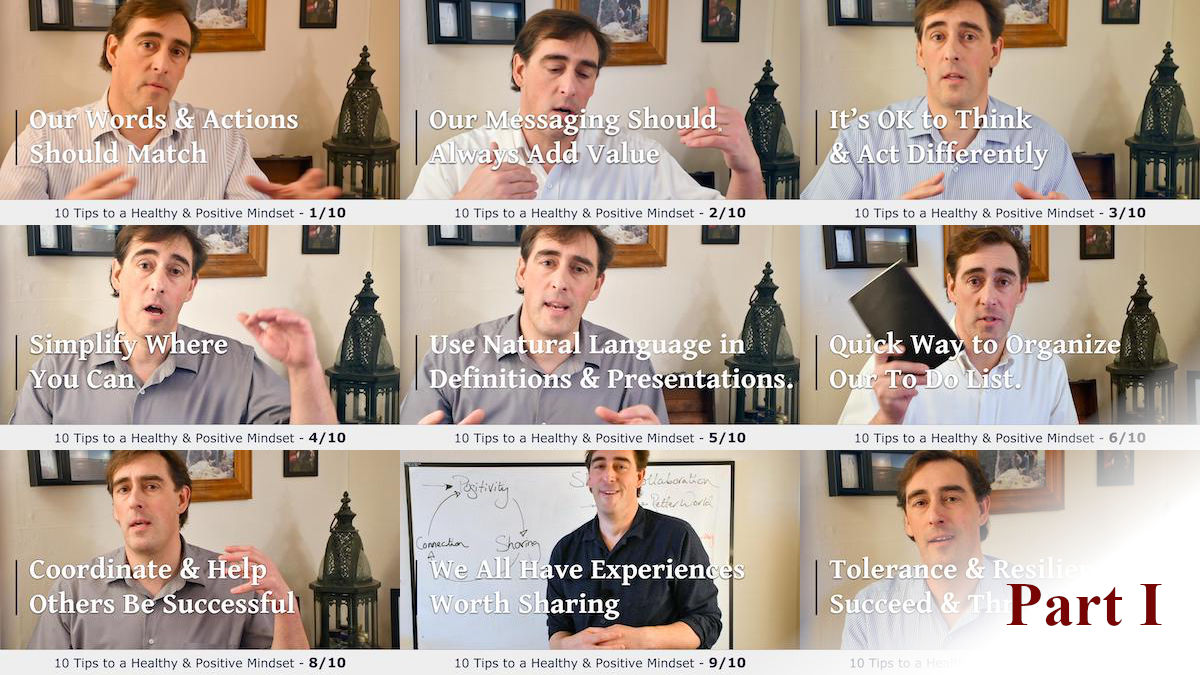Central to all exceptional leaders, no matter their style, is a positive mindset. It’s that calm and reassuring view they have of their team and the work to be done. The secret that helps them excel above their peers.
When there is so much going on around us, exacerbated by the anxiety and stress of a pandemic and a falling economy, how do we reach and maintain a positive mindset? And what’s so special about a positive mindset anyway?
A positive mindset allows us to put our energies into the things we can control instead of the things we can’t. For example, how we think and act, how we communicate, how we organize our work, and empathize with others.
When we do those things consistently, we can deliver what we promised in ways that encourage engagement and help those around us. We succeed at what we set out to do. We’re someone everyone wants to work with again and again.
I have gathered the highlights from my recent LinkedIn series, “10 Tips to a Positive and Healthy Mindset”, into two handy articles to save and come back to.
Part I (tips 1 – 4) lays out four key habits we can adopt to bring about and maintain a positive and healthy mindset.
Part II (tips 5 – 10) highlights ways we can build on those habits to help make our growing workloads feasible and organized, our presentations effective, help others become positive, and how everything comes together when confronted with stressful situations.
Read on for 10 Practical Tips For a Healthy & Positive Mindset – Part II
To get the most from the series I encourage you to visit the LinkedIn posts for each tip, links provided below, and read through the practical advice in the comments or join in the conversation.
Build Good Habits #1: How do others see you compared with how you see yourself?
Do our colleagues and clients see us as the competent, trustable person we think we are, or do they see someone different?
Something I do from time to time is look at the habits of people I admire and those that make me scratch my head in worry. What habits, good and bad, do I have in common?
Highlights from LinkedIn to my question: What habits do you have that were inspired by someone you admire?
Continue the conversation on LinkedIn
- Roseanne: Attitude is very important, because our behavior radiates how we feel. We have the ability to “choose our attitude” despite our circumstances. I learnt this from my Dad. It’s not what happens to us that matters, he would say, but how we respond to it.
- Martin: A good approach that I found motivating as well is to catch yourself to do something well and start creating a habit out of that!
- Doug: I’ve gotten a reputation for being that calming influence in a storm but it is not something I trained for. It was built up over time and consistent interactions with the customers.
Build Good Habits #2: Does your messaging always have value?
Are you someone who provides solutions when you talk, you’re concise, you’re someone others listen to? Our words should consistently help bring confidence and calm, and encourage well thought out discussions.
The ways we do that are as individual as we are, which makes us compelling to listen to.
Highlights from LinkedIn to my question: How do you keep your communications consistent and effective?
Continue the conversation on LinkedIn
- Seán: Listen more than we talk.
- Roseanne, Spencer, Ruheena: Understand your audience and match styles and vocabulary.
- Ahmad: Activate and include your emotional skills in your dialogue, i.e. be flexible and adaptable and don’t be rigid and hard. Be honest but not rude, be transparent but not blunt, be authentic but not artificial, be genuine but not negative, and be yourself.
- Martin: If you are upset about something or someone and ready to send a nasty email, write it without anybody in “To”, put it into the draft, sleep over it, and delete the email. Pick up the phone or go see the person to clear the air.
Build Good Habits #3: It’s OK to think & act differently when we need to.
How do we change and adjust, without worrying about making mistakes and the fear of failure? We think and act differently and treat it like an experiment.
Every time man makes a new experiment he always learns more. He cannot learn less.
Buckminster Fuller
Highlights from LinkedIn to my question: How you were able to make a change, even though it felt daunting at the time.
Continue the conversation on LinkedIn
- Falguni: I tend to discuss it out to understand the reason why we changing and then work towards it… but if the people have changed… / team has changed… then I have to reset for a bit… and start from relationship building and understanding how the new team works
- Roseanne: No action, no movement, no change. Use compartmentalization as an effective strategy, allowing me to handle multiple and sometimes conflicting things, one step at a time.
- Michelle: Change is most successful when everyone can see the need for it. Even if everyone is not aware of the problem, they will need to be a part of the solution. Educate, this can create empathy and galvanize resolve to change. Explain the benefit of outcomes the change should create. Also, lasting change requires loyalty, so listen to everyone’s concerns as you go.
Build Good Habits #4: Simplify where you can.
When we simplify things in our lives and remove the clutter and distractions, anxiety goes down and our focus and enjoyment goes up. When we simplify processes at work, costs and burden go down and team moral… goes up.
Sometimes it’s obvious what to work on but other times we need a different perspective to know what to simplify.
Highlights from LinkedIn to my question: How do you approach simplifying things, particularly when it isn’t obvious what to do?
Continue the conversation on LinkedIn
- Seán: … visualising the 5 most important spinning plates as those being most critical to me ie a plate for family, work, friends, exercise & myself; and keeping those from smashing I can then work out how many other plates I can spin without losing control.
- Michelle: Perspective is the key! Stand on a table, or sit on the floor…see what I mean. Now just think, that was an exercise for only one sense, your vision.
- Roseanne: While it’s important to have a bigger picture, vision, direction, (a roadmap of sorts) It’s then important to break that down into simple, achievable steps. It’s about prioritizing. What’s most important for ourselves, or the people we are leading, at this point in time. And celebrate achievements and successes along the way.
- Ruheena: I try to simplify my time management. For example, if a task requires 4 hours to finish, I see it the other way. How much I can complete in 30 mins? This helps in building my confidence as I achieve my goal every half an hour!
- Emily Ann: I have encouraged teams I’ve managed to talk things out with someone or the group. The other thing is that if I see the majority of people are performing tasks, my natural inclination is to analyze if that way is in fact the most effective and efficient way. I have no problem going a different route against the majority.
- Elizabeth: Focus on what is important.
Ready for Part II? Read on for tips 5 – 10: 10 Practical Tips For a Healthy & Positive Mindset – Part II





